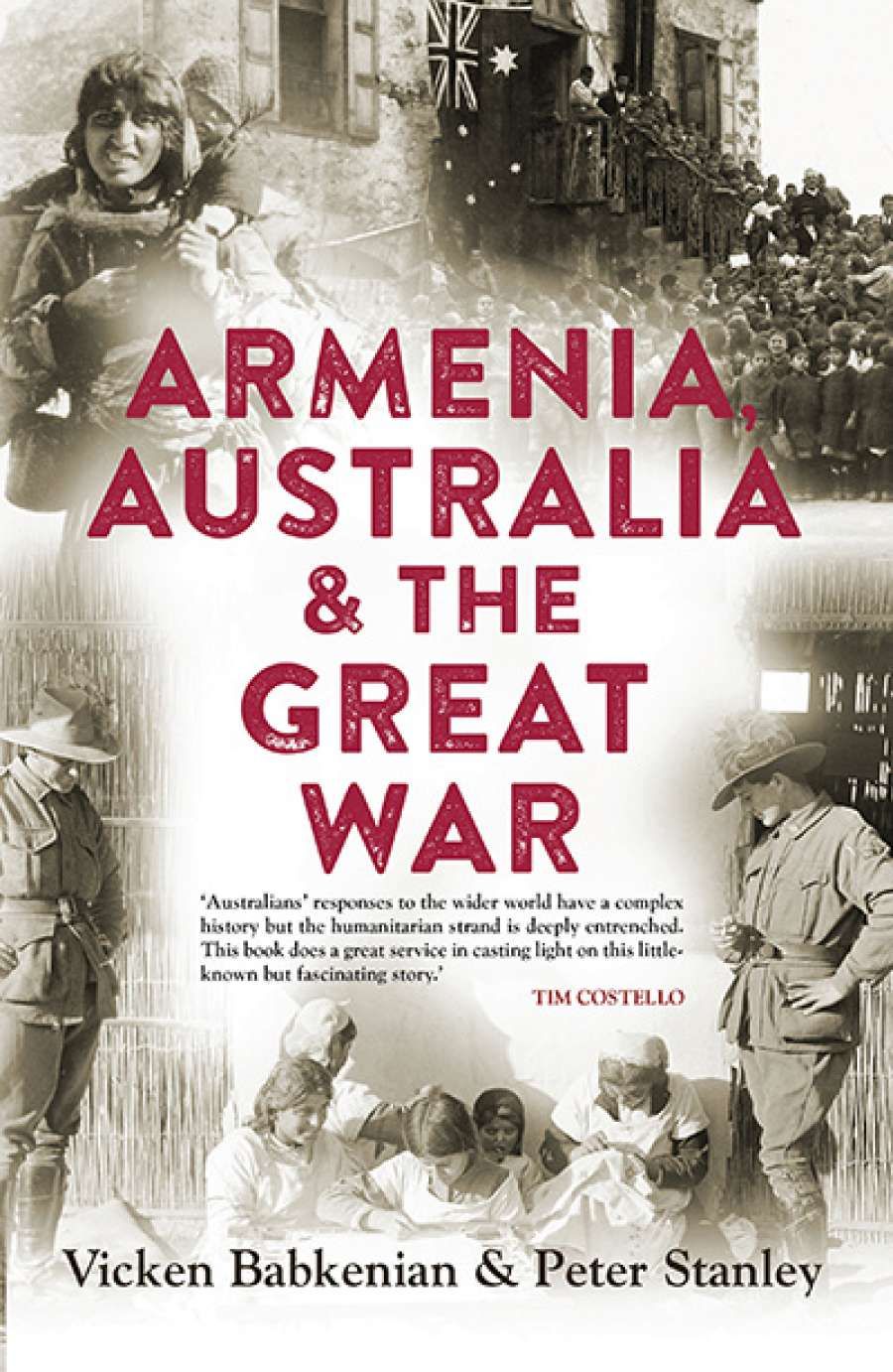
- Free Article: No
- Contents Category: Military History
- Custom Article Title: Joy Damousi reviews 'Armenia, Australia and the Great War' by Vicken Babkenian and Peter Stanley
- Custom Highlight Text:
The Armenian Genocide, which claimed an estimated 1.5 million lives, began in 1915. It continues to cause controversy today and is a hotly contested event; ...
- Book 1 Title: Armenia, Australia and the Great War
- Book 1 Biblio: NewSouth $34.99 pb, 335 pp, 9781742233994
As this book eloquently argues, there are many and varied historic connections that significantly add to the fabric of Australian history. It tells an unknown and powerful story with flair, clarity, and engagement, and introduces a fascinating new narrative in Australia's involvement in World War I, including themes of relief efforts and postwar migration. The 50,000 Armenian-Australians currently living in Australia are very much a part of this history.
The book begins on 24 April 1915, as the Anzacs prepare for battle at Gallipoli. The scene is set for the event that will change the course of Australian history and will construct one of the nation's most enduring founding myths. On that very day, hours before the landing at Anzac Cove, 230 Armenian intellectuals and political, educational, and religious leaders were arrested and deported. The Australian defeat at Gallipoli and the attempt to exterminate the Armenian subjects in the Ottoman Empire bring the histories of these two countries together through an experience of violence, destruction, and death.
However, the connections between the two countries pre-date the war. The authors trace the links between them from the 1850s and the Ballarat goldfields, when Armenians arrived in Victoria in small numbers. Australia's first major encounter with Armenia was in 1894 and 1895, when Armenian villages protested against double taxation imposed by Ottoman officials. The massacres that ensued attracted worldwide attention, including much reportage in the Australian press. This not only sparked international relief efforts by Australians and others, but also some migration to Australia. The few Armenians who managed to emigrate encountered the draconian White Australia policy. Defying the odds, several of them were naturalised. World War I heralded brutal violence against the Armenian population. Australians reported the carnage through eyewitness accounts. Australian prisoners of war in Ottoman Turkey wrote of the atrocity of Armenian deportations and massacres. They provided graphic detail of the slaughter and social upheavals. In November 1915, Ottoman soldiers captured Captain Thomas White, of the Australian Flying Corps. He watched Armenians being rounded up and led to their deaths. His eyewitness report remains one of the most compelling accounts of the genocide.
 Greek and Armenian refugee children in the sea near Marathon Greece, 1915 (Near East Relief. George Grantham Bain Collection, Library of Congress, Wikimedia Commons)
Greek and Armenian refugee children in the sea near Marathon Greece, 1915 (Near East Relief. George Grantham Bain Collection, Library of Congress, Wikimedia Commons)
As elsewhere, Australian relief efforts mobilised to raise funds for the surviving Armenians. Australians were actively involved during and after the war, through the Red Cross, Save the Children, and like organisations. During the interwar years, Australian humanitarians undertook Armenian relief with great compassion and commitment. One of the most notable was Reverend James Cresswell, the progressive Presbyterian minister from Adelaide, who campaigned tirelessly for Armenian relief and travelled extensively both nationally and internationally to promote the cause. Edith Granville's efforts through the League of Nations reflected many campaigns; women in particular were engaged through the League to support relief for Armenia. Migration to Australia by Armenians after 1945 provides another chapter in the history of the relationship between Australia and Armenia, this time as Australian residents.
As the authors rightly note, this history continues in Australia without controversy. Australia has a long Turkish past and is a haven to both Armenian and Turkish communities. The debates continue on another level – terminology. Both the New South Wales and South Australian state governments have recognised the genocide. In 2014, Foreign Minister Julie Bishop announced that the events of 1915 did not constitute genocide.
The book raises pertinent issues that confront most migrant groups: how are the politics of their homeland negotiated in the new country, by the new country's inhabitants, and by the state? While the book is largely concerned with World War I and its aftermath, the voices of recent Armenian immigrants might have provided a new perspective. An oral history of the Armenian community is sorely needed, especially in relation to their memories of war.
The other, broader point concerns Australia's recent role and responsibilities. This book reminds us of the enduring and historical connection of Australia to global movements in providing humanitarian aid, as well as resisting and protesting against xenophobia, populism, fear of refugees, and racial hatred. We have a rich history of such past efforts, demonstrated by the tireless work of humanitarians documented in detail in this account. This history has currency; it invites us to reflect on the extent of Australia's present role in supporting refugees experiencing violence not too far removed from the very region and situation this book insightfully covers.


Comments powered by CComment